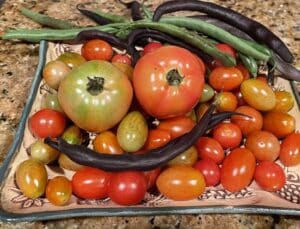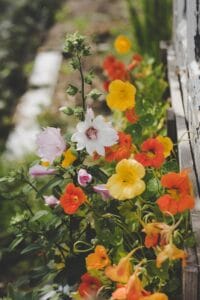Hello, fellow lovers of all things green, It’s spring madness mode for those of us in the horticultural industry and for home gardeners, busy planning and planting this year’s bounty. The same is true for critters such as the peepers I adore in the pond with their evening chorus of mating calls. Don’t you love watching birds scurrying around building their nesting spots? New beginnings bring such joy. While preparing your vegetable garden, consider making friends with companion plants to increase your bounty.
Companion planting can be complicated and contradictory.

Three Sisters Gardening is featured on the reverse of the 2009 Native American U.S. dollar coin.
Attribution:
United States Mint, Public domain, via Wikimedia Commons
The origin of companion planting stems from Three Sisters Gardening by Native Americans who found corn, pole beans, and squash, when grown in groupings, will help support and nourish each other while maximizing space and crop yields. Other benefits of planting different crops together are controlling pests and encouraging beneficial insects and pollinators. However, companion planting is broad-reaching and can be complicated and contradictory.

Some say rosemary, sage, and radishes repel carrot flies; others say they don’t make good companions. It’s true; the more you research, the more confusing companion planting can be. However, the central theme is that planting vegetables in groupings rather than rows of one crop is best. The following are a few sure and straightforward combos that will also add color to your vegetable patch.
A few companions for veggies sure to add color:
Certain companion plants serve as a “trap crop” to lure insects away from others, such as planting radishes around tomatoes to attract flea beetles, which prefer them over tomato plants. Flea beetles damage young seedlings, especially eggplant and tomatoes, stunting their growth and lessening their yields.
Then there’s nasturtium, which draws pests like aphids, keeping them from attacking your veggies. They also deter squash bugs, so planting them amongst your zucchini or other summer squash is wise. Plus, they attract pollinators, including butterflies, bees, and hummingbirds.
Nasturtium flowers, seed pods, and leaves are edible, too—delightful in salads with their peppery mustard-like taste. They’re easy to grow with bold yellow and orange blooms and saucer-shaped foliage, adding color and texture to your vegetable garden. There are trailing varieties (Tropaeolum majus) and bush types, often called dwarf (T. minus).
Marigolds make lovely veggie companions.

Most folks know about marigolds, which are deer-resistant and attract butterflies and hummingbirds. They’re often companion plants in veggie gardens to control insects and nematodes. And you can use them as a spice in cooking.
Another floral beauty is sweet alyssum (Lobularia maritime), which helps control aphids when planted around lettuce. Both are cool-season plants, and you’ll adore the sweet fragrance of the dainty white clusters. They also make a great companion to Swiss chard. Like nasturtiums, they’re an annual here, but they readily self-seed and are edible. While they come in pink and purple, the white flowering sweet alyssum attracts the most pollinators and beneficial bugs like parasitic wasps that gather aphids to feed their young.
Combos such as tomatoes planted with basil taste great together and help deter thrips, which can wreak havoc on peppers.
A Season of New Beginnings


It’s a season of new beginnings while cherishing the joys of the past—As I write, I am sitting on the screen porch where I also record our weekly podcast. Jolee is in front of me, napping on the beanbag chair she has called her own. To the left is a photograph of Miss Ellie Mae with her iconic smile sitting on a rock at the Top of the World, what I call Big Pocono State Park atop Camelback Ski Mountain in Pennsylvania, taken a few months before she joined the angels. With endings come beginnings, along with the memories and love that never pass away— Wishing you a bountiful and happy new season of growth.
Garden Dilemmas? AskMaryStone@gmail.com (and your favorite Podcast App.)
There’s more to the story in the Garden Dilemmas Podcast (@ 1o soothing minutes):
Related Stories you’ll enjoy:
The Legend of Marigolds – Blog Post
Episode 01. About Marigolds, About Mary Stone
Three Sisters Gardening & Jolee’s Emergency – Blog Post
Episode 28. Three Sisters, No-Till Gardening
Helpful Links:
The Old Farmer’s Almanac: Planting, Growing, and Caring for Nasturtium Flowers and Companion Planting Guide for Vegetables.
Better Homes & Gardens article on How to Plant and Grow Sweet Alyssum
*Header Nasturtium photo by Nareeta Martin on Unsplash



